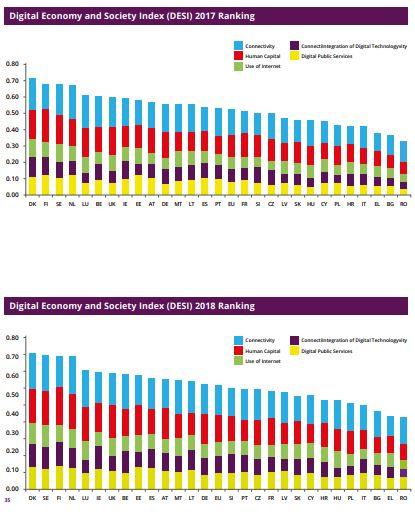Research and Analysis
Introduction
The internet and digital technologies are transforming the way people live, work and communicate today.
We are in the era now known as the digital age or information age. Information is readily available and accessible through digital technologies and people born into this era are described as digital natives – someone who has used the internet and mobile phones since they were a child. Technologies are constantly evolving and developing. We can see this especially in recent years with advances in the internet of things (IOT), artificial intelligence (AI) and machine learning – for example, electric cars, driverless vehicles, contactless payments, smart home appliances. As a result, consumer preferences have changed – people want to access more services online and at a time and place convenient for them.
We are using online services for shopping, banking, paying bills, information and entertainment because they tend to be more convenient and cheaper to use. Research carried out by Ipsos MORI on behalf of Deloitte found that three million people in Ireland, equivalent to 90% of the population, now have access to a smartphone - higher than the European average. The survey revealed that mobile phone usage among older people grew by 6% to 54% from 2016 to 2017, with eight in every ten of those carrying a smartphone. It also found that 83% of Irish people have access to at least one IoT device against a European average of 73%.
As a result of the technological advances in society Local Government needs to evolve and adapt to ensure our citizens, business and communities remain well served.
The importance of the internet to our economy is becoming more and more evident each year. In 2016, Indecon Economic Consultants were commissioned by The Department of Communications, Climate Action and Environment to carry out an Assessment of the macro-economic impact of the internet and digital on the Irish economy.
This report found that:
• The digital economy represents 6% (€12.3bn) of Ireland’s GDP.
• It is growing fast, at approximately 40% since 2012.
• The digital economy is expected to expand to about €21.4 billion or 7.9% of GDP by 2020.
• Currently almost 116,000 direct and indirect jobs are supported, of which 68,000 are directly linked to digital.
• The largest single contributor to the internet part of the economy is online consumer spending.
• Irish consumers spend around €850,000 per hour online, 24 hours a day, which represents more than a 20% increase since 2012.
• Irish consumers expect this to grow by 25% in the next 3 – 5 years.
• 88% of Irish consumers research products online before buying, compared to 79% across the EU.
• Approximately one in seven Irish people (13.5% of the adult population) make a supplementary income on the internet.
In recent years cities around the world are now moving towards the concept of a ‘Smart City’, using technology to improve the way citizens interact with the city. Smart Cities and regions use data and technology to create efficiencies, improve sustainability, create economic development, and enhance quality of life factors for people. Smart Cities is one of the fastest growth markets globally, with Allied Market Research reporting that the global Smart Cities market was valued at $517,629 million in 2017 and is projected to reach $2,402,123 million by 2025, registering a compound annual growth rate of 21.28% from 2018 to 2025.
Smart Dublin, an initiative of the four Dublin Local Authorities, aims to position Dublin as a world leader in the development of new urban solutions, using open data, and with the city region as a test bed. As a founding member of the Smart Dublin initiative in 2016, Fingal County Council has actively sought to capitalise on the abundance of opportunities presented by the global Smart Cities movement for both internal digital transformation and to stimulate economic vibrancy in the region.
Why a Digital Strategy?
Fingal has a population of 296,214, making it the third largest, fastest growing, and youngest population of any county in Ireland. This represents a growth of close to 80% in comparison with 30% nationally since 1996. Since the 2011 census the population of Fingal has increased by 8% and by 2021 the population of this vibrant and diverse county is expected to be over 330,000. The population is ethnically and culturally diverse; 23% of the population were born outside of Ireland. Balbriggan, located in the north of the county, is Ireland’s youngest, fastest growing and most diverse town in Ireland and over half of the population of Mulhuddart in Dublin 15 are under the age of 25.
Fingal’s rapidly growing, diverse, young population presents a myriad of opportunities and challenges for the county. By developing a digital strategy for Fingal, we hope to deliver better services to our growing population and support communities, businesses and citizens to leverage the full potential of broadband and digital technologies.
Fingal has major economic assets, including Dublin Airport, proximity to Dublin City and the Dublin Port Tunnel, road and rail infrastructure and a prime location on the Dublin-Belfast Economic corridor. Dublin Airport provides a significant economic hub for the county.
Fingal has close links with Third Level Higher Education Institutes. Technological University Dublin - Ireland’s first Technological University - has a campus based in Blanchardstown, Dublin 15.
Fingal is also home to the Dublin Enterprise Zone (DEZ). The DEZ comprises of 1,571 hectares of land zoned for office, R&D, High Technology Manufacturing, Industrial and General Enterprise and Employment, and is located just north of the N3 and south of the N2. The DEZ is one of the largest enterprise zones in Ireland and adds €14.4 billion to the national economic output while supporting 34,600 jobs.
Fingal County Council has built a strong and dynamic ICT cluster in the Blanchardstown area with multinational companies such as Synopsys, IBM, Amazon, PayPal and Symantec.
Fingal’s Digital Strategy will leverage the supports of the world-leading science, technology, innovation and research ecosystem to support strategy goals and objectives and grow Digital Fingal.
Fingal is made up of a mix of rural, urban and suburban regions. The OECD has acknowledged the importance of broadband and digital infrastructure to both rural and urban communities. The term “digital divide” is commonly used to refer to different levels of access and use of information and communication technologies (ICTs) and, more specifically, to the gaps in access and use of internet based digital services. Broadband access provides the physical means for using these services, with availability gaps continuing to be a challenge in many rural and remote locations.
The National Broadband Plan (NBP)(2015) aims to deliver reliable high-speed broadband throughout Ireland through a combination of State and commercial investment. Fingal County Council is committed to facilitating the rollout of the NBP and recognises the vital role broadband will play in Fingal’s urban and rural economic and social development.
To help our local economy and communities to take full advantage of the opportunities that digital presents, local digital strategies are of vital importance.

Digital Strategy Policy Context
The European Commission has been a driver of digital for many years. In 2015 the Commission developed Europe’s 2020 Strategy which set out objectives for the growth of the European Union (EU) by 2020. This strategy was built around seven pillars, the Digital Agenda formed one of these key growth pillars. The Digital Agenda’s main objective was to develop a digital single market in order to generate smart, sustainable and inclusive growth in Europe.
The core focus of the European Commission’s Digital Single Market Strategy is for European citizens to benefit from developments in digital connectivity, digital skills, digital public services, and investment in research, development and innovation in ICT. The EU Commission is encouraging and supporting member states to develop their digital infrastructure and services through a series of funding opportunities. The WiFi4EU initiative was launched in May 2018 with a fund of €120 million and aims to promote access to wireless connectivity and usage in public places. The EU Commission has also proposed to invest a further €9.2 billion in the first ever Digital Europe programme. Fingal County Council aims to optimise its digital infrastructure and services through EU Commission funding supports and other support and development initiatives.
As part of the Digital Single Market strategy, the European Commission annually publishes the European Digital Progress Report (EDPR), which monitors progress in digital policies in the Member States.
| Digital Dimension | Description |
|---|---|
| Connectivity | Fixed broadband, mobile broadband, broadband speed and prices |
| Human Capital | Internet use, basic and advanced digital skills |
| Use of Internet | Citizens’ use of content, communication and online transactions |
| Integration of Digital Technology | Business digitisation and eCommerce |
| Digital Public Services | eGovernment |
The 2018 report showed that Denmark, Sweden, Finland, and the Netherlands have the most advanced digital economies in the EU followed by Luxembourg, Ireland, the UK, Belgium and Estonia on the Digital Economy and Society Index (DESI).

In 2017, Ireland ranked eight as most digitised nation among its EU Member States and in 2018 Ireland improved its overall performance and was ranked sixth overall in the Digital Economy and Society Index report.
In recent years, the Irish Government has prioritised the delivery and implementation of the EU digital agenda and Digital Single Market through development and implementation of the National Broadband Plan and by progressing national and local digital strategies.
The Department of Communications, Climate Action and Environment (DCCAE) has been a driver of digital for some time. In 2013, DCCAE published the National Digital Strategy for Ireland. It focused on three target areas:
• Enterprise – a key aim was to get 10,000 businesses online for the first time and 2,000 trading online
• Citizens – a key aim was “to halve the number of “non-liners” (people who have not yet engaged with the internet) by 2016”
• Education – among many initiatives the “completion of the rollout of 100mbs to all post primary schools” was a key target
Under the Action Plan for Jobs 2018 a framework for a high level National Digital Strategy is currently in development.
The purpose of this Strategy is to provide a whole of government approach to digital and it will enable Ireland to maximise the economic and societal benefits that arise from on-going digital developments. A Digital Strategy Interdepartmental Group has been established to support the National Digital Strategy.
Local Level
At a local and regional level digital already plays an important role in existing strategies. The Fingal County Development Plan 2017-2023, Section 6.5 Information and Communications Technology outlines Fingal County Council’s policy to grow the ICT presence in the county to maximise growth opportunities in the sector.
Fingal Libraries Development Plan 2018-2023 identifies the need for access to information technology, digital services and skills through its core objectives. Objective 5 focuses on technology. It states that states that Fingal Libraries will ‘provide training opportunities to bridge the digital divide internally and externally. Fingal Libraries are committed to providing an innovative and technology-rich service that will meet the present and future needs of our communities’. Access to high-speed broadband in all Fingal Libraries is an action within the Library Development Plan.
Fingal Age Friendly Strategy 2018-2023 identifies the need to support senior citizens to bridge the digital divide. The increasing digitisation of society is impacting on the lives of senior citizens with the closure of post offices, banks and a proliferation of services being carried out online. In this context, there is a need to ensure our older citizens are facilitated and supported in a manner which bridges the digital divide while still respecting their choices and needs. The Age Friendly Strategy outlines a core goal to help bridge that divide.
The Fingal Skills Strategy has identified critical skills shortages for the Professional Services sector. The analysis indicates a significant gap of up to 919 Professional, Associate Professional and Technical Occupations per annum. In order to meet the demand for highly skilled technical workforce the report recommends that education providers and Fingal County Council work to improve promote digital skills services and courses.
Fingal Local Economic and Community Plan (LECP) 2016–2020 outlines the importance of digital for the growth of communities. The plan prioritises digital in:
• High-Level Goal 4: To maximise training and job creation working opportunities by activating the potential within local communities.
• Action 33: Maximise the potential of e-learning, up-skill communities in ICT, and facilitate access to technologies so as to enable the use of eLearning and access to information.

Fingal's Digital Landscape
With regard to telecoms infrastructure, Fingal is better served than its more rural neighbouring counties, but it still experiences a rural-urban divide for high speed broadband services which has left rural communities disadvantaged for their living and working requirements. Latest figures available from the DCCAE (Q2-2019 - Table 1) show just under 9% of premises have no access to reliable high-speed broadband services.
Engagement with local citizens and business have revealed that pockets or blackspots of poor connectivity exist within the blue area of the National Broadband Plan map. A consultation on conclusion of the National Broadband Plan mapping exercise for the 'Intervention Area' has recently been undertaken (Q3-2019) with relevant agencies and the telecoms industry to update the National Broadband Plan intervention area.